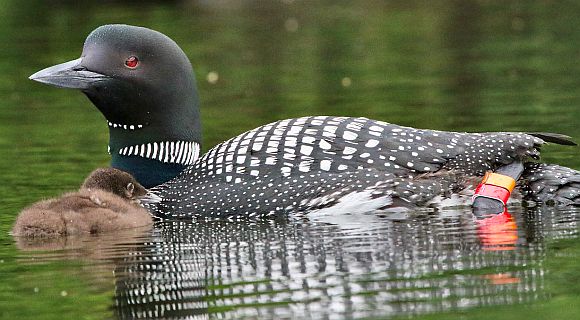Banding Loons
by Dick Greenan

An adult female loon banded in Long Pond in 2020.
Last night we had a very successful evening of banding six adult loons in Great Pond by the talented and experienced folks at Biodiversity Institute in Gorham, Maine in addition to our loon expert and consultant, Lee Attix. Last year, we banded seven birds, five in Long Pond and two on Great Pond, over two nights, so six birds in one evening was indeed, a very productive evening.
Loons are captured for determination of age, sex, and overall health by assessing weight, leg and beak lengths, and blood and feather analyses for heavy metals. They are banded for easier recognition on future surveys and to track successful nesting pairs. By first surveying the territories early that morning of the banding, the researchers search for an adult pair with at least one chick. They then return in the dark and approach the territory with a spotlight and binoculars.

A loon chick banded in Great Pond in 2020.
Once the adult(s) and chick are spotted and held in contact with the spotlight, they are carefully and very slowly approached while calling the birds in with a chick call. While following the light and call, the adults generally swim right up to the boat. Once alongside, they are scooped up with a large net and secured by other crew whose responsibilities are to secure that head and deadly beak with a towel and tucking under the arm pit of the volunteer holding the loon in his/her lap.
Remarkably the loon has a respiration rate similar to ours and can be quite docile in the arms of the crew but can also in an instant, without warning, kick out those powerful legs in a raucous escape attempt!

A successful banding experience: A banded adult swims with a chick.
It takes about thirty minutes to obtain two vials of blood, three feather samples, and those numerous measurements. During this period the chick is either secured in a blanket lined box or held by a crewmember, which is a sobering experience enjoyed by all. Last year, we were able to measure Great Pond's Ram Island chick that was just old and large enough to have his/her own bands!
These evening captures (and releases!), measurements, and bandings allow the Belgrade Lakes Association and others to not only better assess the health of our loon population and breeding results, but also to better assess these collective trends so that we do not get flat-footed if and when our loon population becomes further threatened.

Dick Greenan is chairman of the Belgrade Lakes Association's Loon Preservation Project. If you have a particular question regarding our Belgrade loon population, please email your inquiry to info@blamaine.org, and he will try to answer you either in this column or via email.
<— Previous Article • Summaries • Next Article —>
©2021 by Summertime in the Belgrades. All rights reserved.

